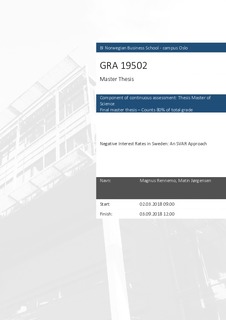Negative interest rates
Abstract
Following the financial crisis of 2008, several central banks have experimented by
setting negative policy rates. In this master thesis, we want to examine the effect
of negative interest rates on the Swedish economy. Sweden has since 2015 had
policy rates below zero, which has raised many interesting questions. We are
particularly interested in whether negative interest rates are expansionary.
To answer this, we look at the general development in the Swedish economy and
compare this to the economic developments of other countries adapting to
negative interest rates. We find that Sweden have over the last years experienced
positive developments in its economy, with raising inflation, decreasing
unemployment and increased output. To examine if this is due to monetary policy
shocks or not, we establish two empirical SVAR-models. One model examining
monetary policy when policy rates are positive and the other when policy rates are
negative.
By simulating an expansionary monetary policy shock, we find that the Cholesky
model using data when policy rates where positive show overall expansionary
effects, which is in line with SVAR literature. On the other side, our Cholesky
model using data after policy rates became negative shows contractionary effects
on industrial production and no effect on CPI. However, on impact real effective
exchange rate depreciates more under negative policy rates, than under positive
policy rates.
This lead us to conclude that the major driver for the economic developments in
Sweden has been other factors than monetary policy alone. Hence, at least for the
case for Sweden are irrelevant or even contractionary.
Description
Masteroppgave(MSc) in Master of Science in Business, Economics - Handelshøyskolen BI, 2018
